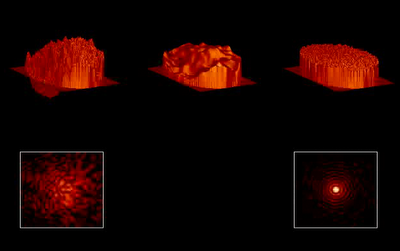A New Project
Jeff has me over here next week to work with some people from the American Museum of Natural History. I had no idea, but museums are a lot like universities in that they have faculty, research grants, tenure, etc. The people I'm working with are physicists/astro people who do the same thing I do (write proposals, build instruments, go observing), they just happen to be from a museum in New York. Go figure.
We're working on the Lyot Project (pronounced leigh-oh, think French). I actually get to use the AEOS adaptive optics system, which is something like an "extreme AO" system. Basically, the optics use some number of correction points to try and correct the blurring caused by the atmosphere. Typical AO systems use 30-100 or so correction points, but we have 940. Awesome!
This movie was pretty cool - On the top it shows a blurred wave on the left, the calculated correction (940pts) in the middle, and the corrected wave on the right. A perfect correction would make a perfectly flat circle. The image of the star before and after is on the bottom.


2 Comments:
Wow, that's some pretty slick shit. In EE jargon it seems they are demodulating the atmosphere to retrieve the 'known' carrier. I wonder how much can be inferred about the atmosphere using that correction signal. It doesn't say on their website but do they any lasers to measure the predicted wavefront distortion or is it entirely based upon the assumption of a uniform front?
Neat stuff, you astronomers get all the cool toys :).
-NJ
hey! you can definately translate my jargon to EE that way - we assume the known carrier is a plane-wave, and that the star should ideally be a point.
the fancy AO systems do have a laser that they tune to sodium - it reflects off a layer caused by micrometeorite vaporization something like 20km up. they use this as a "point-source" as well. everything hinges on the assumption of a uniform front from a point source.
it does say a lot about the atmosphere - there's an entire branch of meteorology/astronomy that studies turbulence and atmospheric structure, and how it effects images. it's some really neat stuff...... there's two major layers - ground and high, both of which act in funny ways.
Post a Comment
<< Home